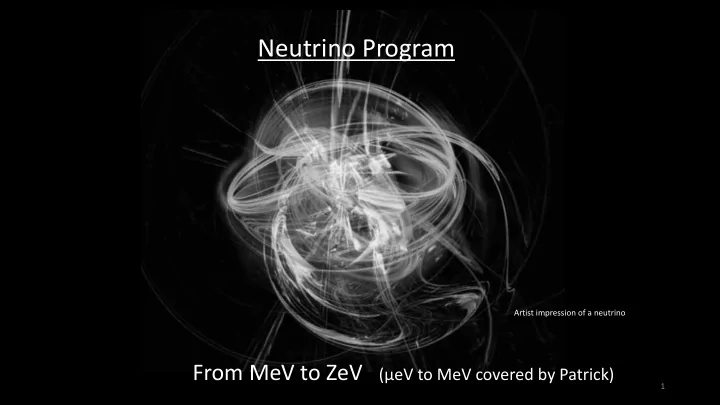

Neutrino Program Artist impression of a neutrino From MeV to ZeV (μeV to MeV covered by Patrick) 1
The discovery of neutrino oscillations is the most solid evidence for physics beyond the original formulation of the Standard Model. It is possible to “repair” the Standard Model by introducing a coupling to the Higgs field, but: Very small masses: Yukawa coupling <10 -12 ? Neutrino mixing ≠ Quark mixing Alternative attractive solutions involving (as of yet unproven) Majorana character of neutrinos exist. Neutrino mass ordering (123 or 312) still not unambiguously determined. CP-violation in neutrinos: opens possibility of leptogenesis. Sterile neutrinos: experimentally still a very confusing picture. Neutrinos are an excellent gateway towards new physics beyond the SM. 2
Neutrino oscillation program at Nikhef: KM3NeT, DUNE KM3NeT: ORCA: atmospheric neutrinos, few GeV to few tens of GeV (ARCA: cosmic neutrinos) Oscillation physics, sterile neutrinos, non-standard interactions,… Oscillation parameters Neutrino mass ordering sensitivity 3 years ORCA ORCA: ~6 Mton 50000 ν/year Data analysis together with JUNO increases sensitivity 2590 km Option: beam from Fitting Δm 231 with the Protvino to ORCA, wrong mass ordering access to CP-violation hypothesis leads to EoI submitted tensions JUNO-KM3NeT 3
Oscillation physics: Deep Underground Neutrino Experiment (DUNE) CP violation sensitivity δ CP resolution Wideband ν beam from 1.0-2.4 MW p beam at FNAL Baseline 1285 km, relevant E ν a few GeV Far detector: 4 x 10 kton LAr TPC, 1500 m underground First module 2026, beam 2029? Near detector: various technologies, large event sample Very challenging, but rewarding experiment: full spectrum of oscillation physics protoDUNE Nikhef: DAQ, computing, event classification, ProtoDUNE single phase ProtoDUNE at CERN: data taken 2018, analysis in progress ProtoDUNE II at CERN 2022- even closer to real DUNE 4
Mount Rushmore Main shaft Shaft above DUNE Lead, South Dakota 5
Cosmic neutrinos Diffuse cosmic flux, and point-sources Sources: CR acceleration, DM annihilation Galactic sources: supernovae, SN remnants, pulsar wind nebulae, X-ray binaries,… Extragalactic sources: active galactic nuclei, compact binary mergers, gamma ray bursts, tidal disruption events,… source: GRAND Cosmogenic neutrinos: from UHECR- γ interactions Point-sources still need unambiguous identification Measure energy spectrum, correlate with γ -rays Multimessenger astrophysics, also transients Neutrino-nucleon cross section at UHE (in atmosphere/water) Flavour composition BSM physics Lorentz violation studies New neutral heavy leptons Binary neutron star merger Blazar Cosmic neutrinos as a tool, but also a probe of BSM physics at Ultra High Energies/in extreme environments 6
Experimental facilities: KM3NeT/ARCA 2 building blocks, > 1 km 3 Northern Hemisphere Superior pointing resolution Significance of diffuse flux detection ν- µ angle 0.05 degree Ve Vela X Detection of ν flux Pulsar Wind Nebula Vela-X Bonus: cosmic ray program in KM3NeT earth tomography with neutrinos 7
Experimental facilities for UHE neutrinos: KM3NeT-acoustic / GRAND KM3NeT-acoustic : detect the sound of UHE (>10 18 eV) neutrino-induced showers in water Sources: Cosmogenic neutrinos (GZK cutoff) Blazars Tidal Disruption Events (TDE) TDE also a source of GW in the LISA band. GW data analysis techniques apply. Plan: Proof of concept within KM3NeT2.0 roadmap: up to 2023 Pathfinder infrastructure 10-100 lines up to 2028 Investigate industrial sensor manufacturing. Beyond 2030: 100 km 3 seawater instrumented, > 1000 lines (e.g. Pylos KM3NeT site?) TNO Optical fiber hydrophones Bonus: multidisciplinary program: sea science, marine biology 8
Giant Radio Array for Neutrino Detection (GRAND) Detect UHE neutrinos by measuring neutrino-induced extended air showers with radio antennas cosmogenic neutrinos Plan: Proto300 (300 antennas, 300 km 2 ) 2020-2024 test self-triggering GRAND10k 2025-203x first neutrinos > 0.1 EeV? GRAND200k >203x 20 hotspots of 10k antennas, neutrino astronomy > 1 EeV Sites in China under investigation 9
Technology Large area, fast, efficient, cheap single photon detection. PMT, SiPM, APD,… Large areas to be covered, poorly – or not at all accessible: Low-power and low-cost electronics. High-reliability electronics. Risk analysis. Accurate timing over large distances, no GPS. Cheap, reliable mechanics, able to withstand extreme environments. LAr scintillation light detection: UV photons. Cheap, sensitive, low-noise hydrophones. 10
Computing “Triggerless” running, massive data analysis needs. Fast, real-time data processing. Machine learning techniques, already succesful in pattern recognition, event classification. Inter-group activity at Nikhef? Open science: be pragmatic, listen to the users. Need for more use of professional, open source, documented tools, and less home-made software. In particular also beneficial for collaboration with astronomy. 11
Strategy Wishlist Complete KM3NeT : ORCA 2024, 1st block ARCA 2024, 2nd block 2026? Strengthen DUNE effort : little manpower/funding so far. Fantastic oscillation experiment! Develop acoustic neutrino detection program in phases Build GRAND in phases Create a multi-messenger effort : at Nikhef: already big crosstalk XENON-KM3NeT-PAO nationally: with Gravitational Waves, and with astronomy community (complete EM spectrum) GW should not overpower other APP efforts Align and synchronize APP funding agencies. Facilitate doing experiments in China. 12
Recommend
More recommend